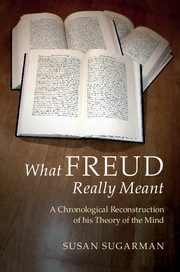Book contents
- Frontmatter
- Dedication
- Contents
- Acknowledgments
- Introduction
- 1 Freud on psychoanalysis: Five Lectures on Psychoanalysis (1909a)
- 2 The pleasure and reality principles: “Formulations regarding two principles in mental functioning” (1911); “The psychology of the dream-processes” from The Interpretation of Dreams” (1900)
- 3 Ambivalence and the origin of the civilized mind: “Taboo and emotional ambivalence” from Totem and Taboo (1913b)
- 4 Narcissism as a stage in development: “On narcissism: an introduction” (1914)
- 5 The impetus to the mind: “Instincts and their vicissitudes” (1915a)
- 6 The possibility of repression: “Repression” (1915b); “Negation” (1925a)
- 7 The unconscious and the structure of the mind: “The unconscious” (1915c)
- 8 Beyond the pleasure principle: Beyond the Pleasure Principle (1920)
- 9 A new architecture of the mind: The Ego and the Id (1923)
- 10 Pleasure revised: “An economic problem in masochism” (1924)
- 11 Civilization, morality, and the pursuit of pleasure: Civilization and its Discontents (1930)
- Epilogue: What Freud really meant
- References
- Index
Introduction
Published online by Cambridge University Press: 05 April 2016
- Frontmatter
- Dedication
- Contents
- Acknowledgments
- Introduction
- 1 Freud on psychoanalysis: Five Lectures on Psychoanalysis (1909a)
- 2 The pleasure and reality principles: “Formulations regarding two principles in mental functioning” (1911); “The psychology of the dream-processes” from The Interpretation of Dreams” (1900)
- 3 Ambivalence and the origin of the civilized mind: “Taboo and emotional ambivalence” from Totem and Taboo (1913b)
- 4 Narcissism as a stage in development: “On narcissism: an introduction” (1914)
- 5 The impetus to the mind: “Instincts and their vicissitudes” (1915a)
- 6 The possibility of repression: “Repression” (1915b); “Negation” (1925a)
- 7 The unconscious and the structure of the mind: “The unconscious” (1915c)
- 8 Beyond the pleasure principle: Beyond the Pleasure Principle (1920)
- 9 A new architecture of the mind: The Ego and the Id (1923)
- 10 Pleasure revised: “An economic problem in masochism” (1924)
- 11 Civilization, morality, and the pursuit of pleasure: Civilization and its Discontents (1930)
- Epilogue: What Freud really meant
- References
- Index
Summary
Sigmund Freud described as the aim of his life's work to “throw light upon unusual, abnormal or pathological manifestations of the mind” (1936/1981, p. 447). That entailed tracing them back to the psychological forces behind them and discovering the basic mechanisms behind those forces. The general theory of mind he fashioned from that effort attempts no less than the explanation of human mental life from its merest beginnings to the labyrinthine processes capable of producing both mental illness and our highest intellectual and cultural achievements.
Freud has taken his place among the thinkers who have changed our lives. We see human mental life through his idiom. For instance, the conventional wisdom holds that our motives may be other than what they seem, our proclivities may express our early history, and we further our mental health by being aware of our inner longings. But a far more complex and nuanced theory lies behind such virtual commonplaces. Freud's theory is a structure of closely interlocking interdependent parts, whose most fundamental constructs Freud modified, expanding, revising, and incorporating them into an increasingly sophisticated vision.
To know what Freud really meant requires careful tracking of his process and that evolving vision. That tracking is the work of this book. Treating eleven of Freud's essential theoretical writings in chronological sequence, it reveals a systematic structure evolving in complexity over the course of Freud's career. It takes each argument apart and reconstructs it to articulate the theory as perspicuously as possible from the principles Freud designated as foundational.
That foundational understanding is critical to all who would know Freud, from first-time readers to scholars across the many disciplines that study or apply Freud's thought – among them psychology, anthropology, sociology, history, philosophy, literary studies, architecture, and the arts. But as a result of the assimilation of Freud's work by so many fields, it has become fragmented – a concept here, a trope there, claims isolated from their germinating context. Such efforts, in removing the ideas from their original setting, inevitably distort them. We lose sight of what the ideas are as Freud construed them and why he construed them as he did.
- Type
- Chapter
- Information
- What Freud Really MeantA Chronological Reconstruction of his Theory of the Mind, pp. 1 - 3Publisher: Cambridge University PressPrint publication year: 2016



